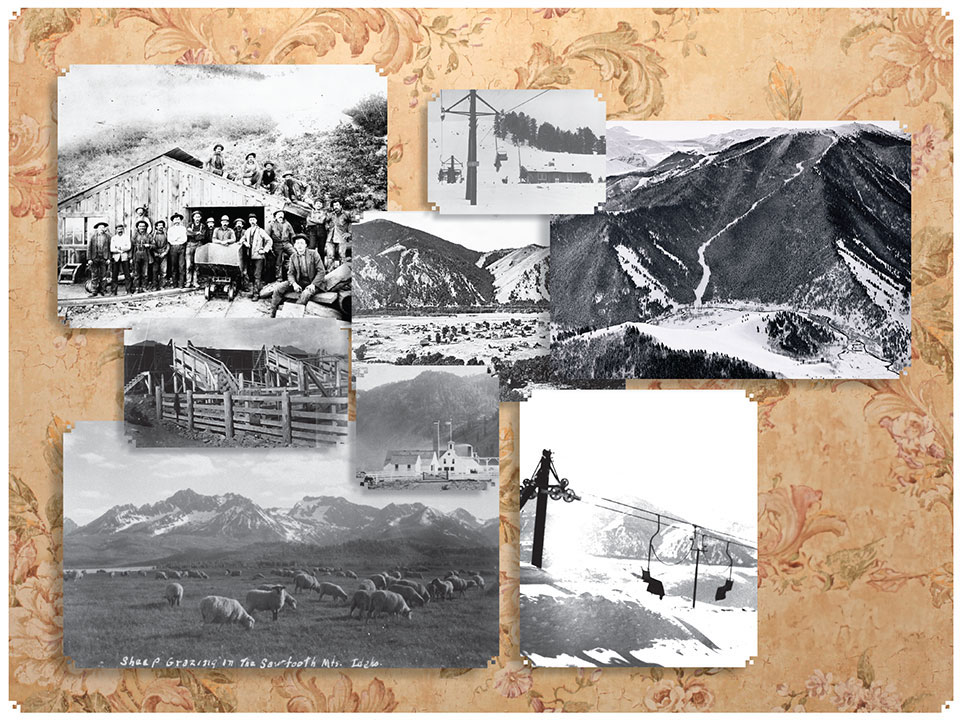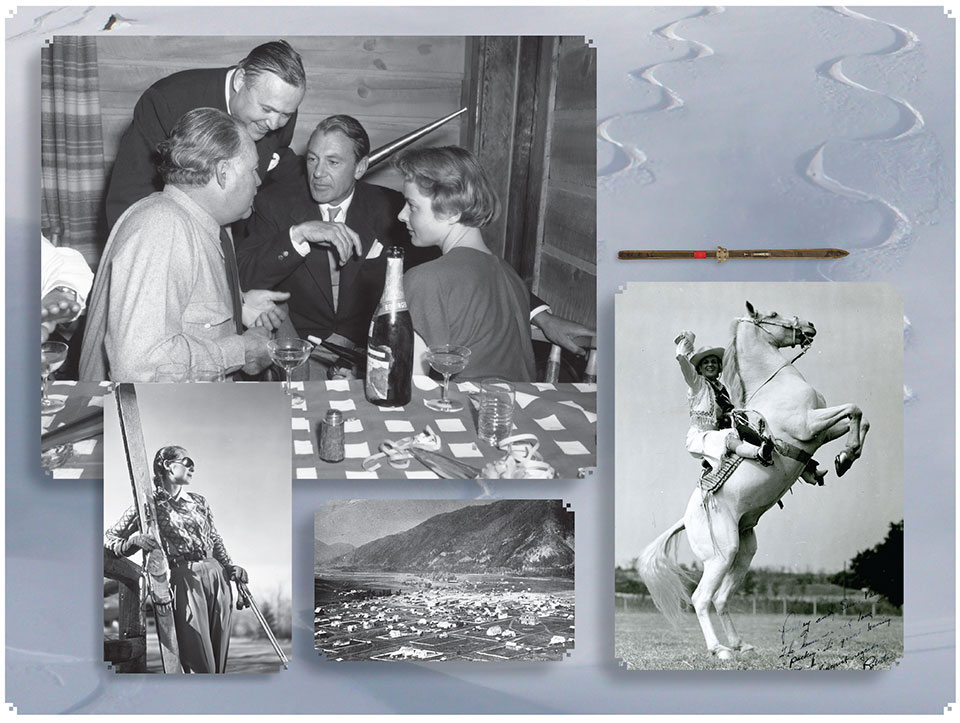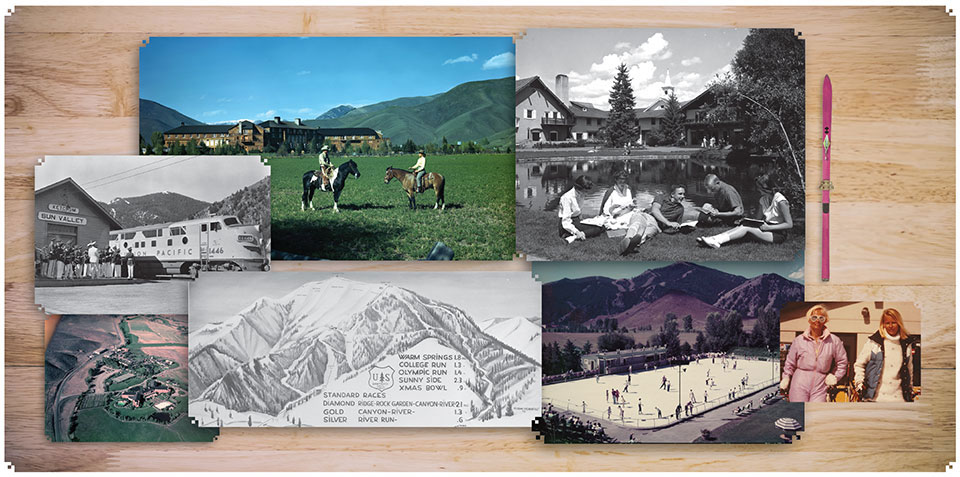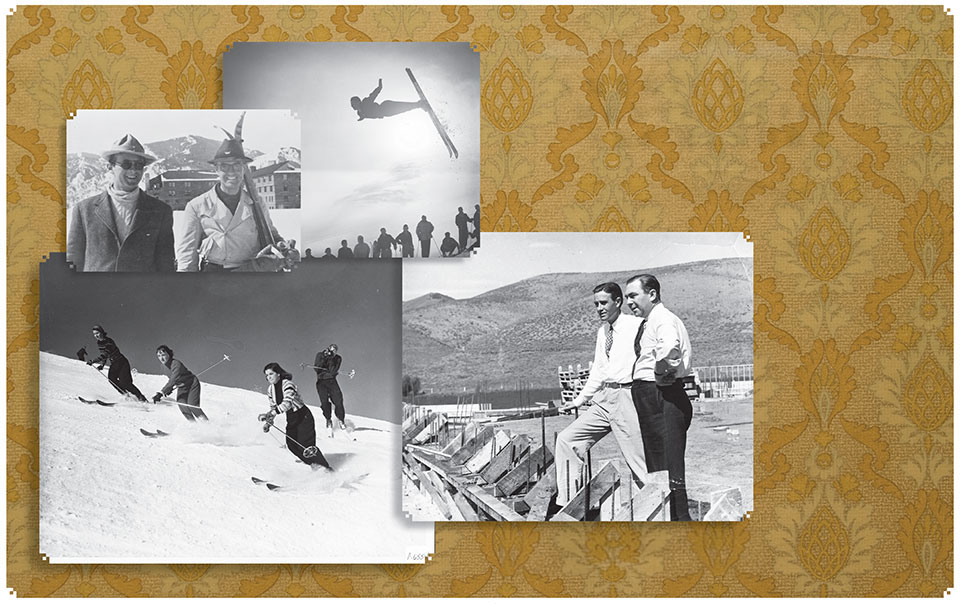Inside Sun Valley’s Glamorous History
America’s First Destination Ski Resort
by Cassidy Mantor
photos courtesy The Community Library
Above: Averell Harriman – chairman of Union Pacific Railway – enlisted Austrian ski instructor Count Felix Schaffgotsch to help scout the perfect place for the resort.
Almost 100 years ago, the Winter Olympics in Lake Placid triggered a new wave of winter sports enthusiasm across America. Railroad tycoon and marketing genius Averell Harriman – chairman of Union Pacific Railway – wanted to get in on the action and began scouting for a site to build what he envisioned to be the first destination ski resort in the country. Harriman wanted to model the resort after the great European ones and enlisted Austrian ski instructor Count Felix Schaffgotsch to help scout the perfect place for the resort. They found the right site in Idaho, in a remote mining valley in the Sawtooth Mountains between Bald and Dollar Mountains.
Sun Valley Resort opened in December 1936. Harriman wanted guests to take his trains to go ski and there were direct lines from Los Angeles to Ketchum. As part of his marketing plan for the railroad as well as the resort, he invited celebrities to ride the train to Sun Valley. Hollywood stars like Clark Gable and Ingrid Bergman helped build up Sun Valley’s glamorous image in the 1930s and ‘40s. Ernest Hemingway finished writing For Whom the Bell Tolls in his room at the Sun Valley Lodge.

A Union Pacific engineer by the name of James Curran would design the first modern chairlift in the world. Charles Proctor, a legendary ski racer, ski jumper, and Olympian, designed the trails. Harriman brought Austrian ski instructors to Sun Valley to give guests the complete European experience.
BEFORE THE RESORT
Before Sun Valley became an integral part of American ski culture, prospectors discovered silver, lead, and other minerals in the 1880s. Ten years later when the silver industry crashed, sheep farmers moved in and became the main source of economy for the valley. In the 1930s, when Count Schaffgotsch overheard a discussion about a small mining town named Ketchum, he visited and wired Harriman that he’d found the hidden gem they’d been looking for. The land that would become Sun Valley included a 3,200-acre sheep farm known as Brass Ranch. The Count met with the ranch owner’s daughter, Roberta Brass, who guided them around the area, and in 1935, her father Ernest agreed to sell the land for about $4 per acre.
Harriman hired Los Angeles-based architect Gilbert Stanley Underwood and Company to begin designing the resort. It cost about $1.5M to build, and just seven months later, Sun Valley Lodge opened. The challenge, however, was that in the 1930s and ‘40s, Americans still had not fully embraced winter sports for their holidays. Harriman had to show people how easy it would be to get onto the slopes to ski. A Union Pacific engineer by the name of James Curran would design the first modern chairlift in the world. Charles Proctor, a legendary ski racer, ski jumper, and Olympian, designed the trails. Harriman brought Austrian ski instructors to Sun Valley to give guests the complete European experience.

Still independently operated, Sun Valley Resort is steeped in tradition and has held the #1 spot on SKI Magazine’s reader survey of the best resorts in the U.S. for the past four years. Off the ski slopes, Sun Valley’s refined culture extends into the town of Ketchum with luxurious lodging and dining.
As much as Sun Valley Lodge was a marketing plan meant to boost ridership on the trains, Harriman also knew the resort needed its own marketing, so he hired PR exec Steve Hannagan to brand it. Hannagan was the one who began bringing celebrities to town and coined the name Sun Valley to represent the 250 days of sun light. Clint Eastwood’s Pale Rider and Marilyn Monroe’s Bus Stop are some of the films that were shot in Sun Valley.
The marketing efforts caught on and Sun Valley became the epicenter of American ski culture. Filmmakers Warren Miller and Dick Barrymore, along with over 56 former and current Olympians including Gretchen Fraser and Picabo Street, called Sun Valley home. Bobby Burns, the inventor of “hot dog skiing” and the leader of what would become freestyle skiing, is also from Sun Valley. Stein Eriksen made Sun Valley his first stop in America after winning gold in Oslo and taught at Sun Valley Ski School for several years before moving on to generate enthusiasm for skiing across the U.S. Still independently operated, Sun Valley Resort is steeped in tradition and has held the #1 spot on SKI Magazine’s reader survey of the best resorts in the U.S. for the past four years. Off the ski slopes, Sun Valley’s refined culture extends into the town of Ketchum with luxurious lodging and dining.

Although Harriman started Sun Valley as a winter resort, horseback riding, golf, shooting, archery, and even ice skating were added in the summer of 1937, making Sun Valley a year-round destination.
BUILDING A MODERN SKI CULTURE
Residential development around Sun Valley began in the 1960s when Janss Corporation was brought in to give the resort a facelift. Union Pacific, the original owners, decided they wanted to sell instead, so former Olympic skier and founder of Snowmass, Bill Janss, and his brother bought the resort in 1964 and owned it until the late ‘70s. The northern Warm Springs area and Seattle Ridge were developed, and condos and homes were built. Beginning in 1972, the Elkhorn area was established. In 1977, Utah businessman Earl Holding, founder of Sinclair Oil, bought the resort and improved the facilities. The resort is still owned by the Holding family.
While skiers think of “Sun Valley” as the resort, the area also includes the nearby Wood River Valley towns of Ketchum, Hailey, and Bellevue. Blaine County, Idaho, prioritizes protecting the natural beauty, an initiative that continues to draw celebrities and those seeking a deeper connection to the environment. Scenic views, clean air and water, and abundant wildlife are some of the characteristics that make it so special.
Although Harriman started Sun Valley as a winter resort, horseback riding, golf, shooting, archery, and even ice skating were added in the summer of 1937, making Sun Valley a year-round destination. Today, fly fishing, hiking, and biking are summertime draws as well as a robust arts scene. Sun Valley hosts the Sun Valley Writers’ Conference, the Sun Valley Film Festival, free symphony concerts, and numerous performing arts venues and troupes, thoughtful lectures, and 12 galleries representing regionally and globally acclaimed artists. There’s a sophisticated glamour to Sun Valley’s culture that other mountain towns have tried to replicate, but this is the original. There’s a sense of magic in town that can best be summed up just as Count Schaffgotsch described in a wire to Harriman – Sun Valley is “place perfect.”
